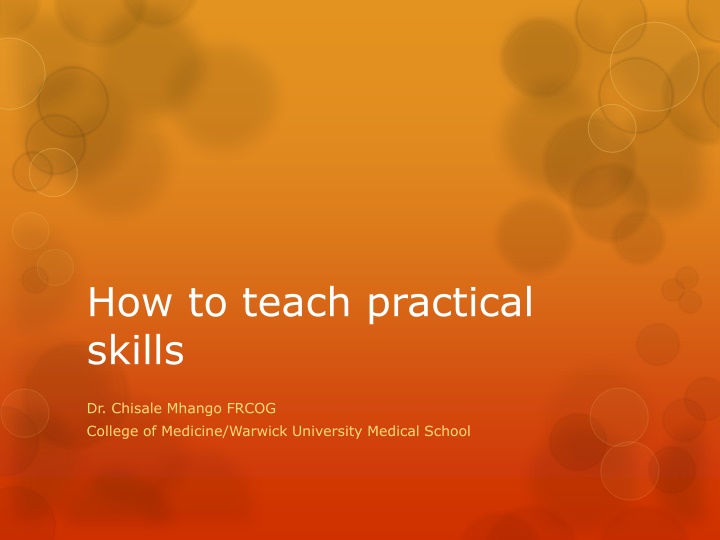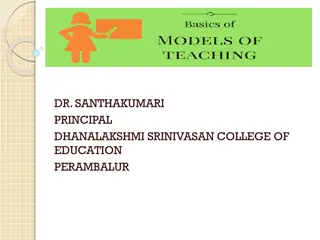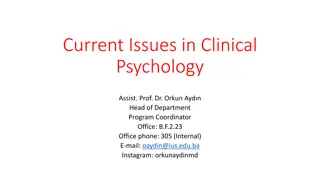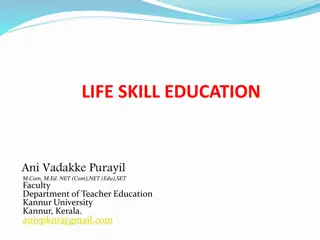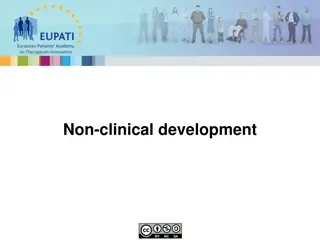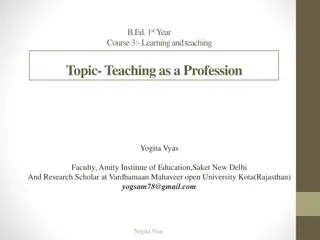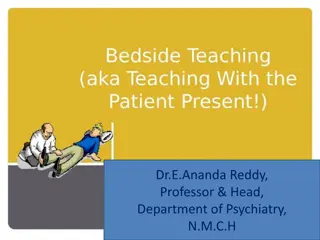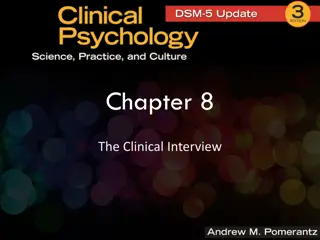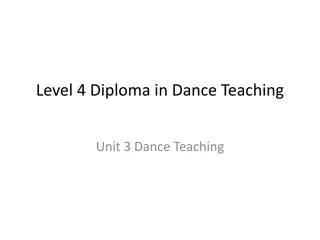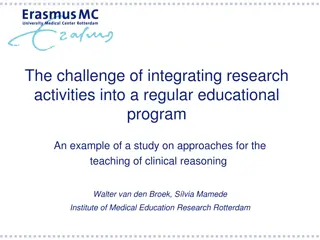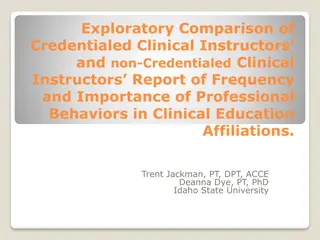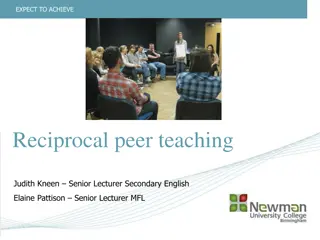Teaching Practical Skills in Clinical Environments
Teaching practical skills involves precise instructions, visual aids, and step-by-step procedures to enable learners to master hands-on tasks. The process requires a structured approach and utilization of various sensory perceptions. Practical skills are essential in clinical settings where competency is demonstrated through the application of knowledge and physical dexterity.
Download Presentation

Please find below an Image/Link to download the presentation.
The content on the website is provided AS IS for your information and personal use only. It may not be sold, licensed, or shared on other websites without obtaining consent from the author.If you encounter any issues during the download, it is possible that the publisher has removed the file from their server.
You are allowed to download the files provided on this website for personal or commercial use, subject to the condition that they are used lawfully. All files are the property of their respective owners.
The content on the website is provided AS IS for your information and personal use only. It may not be sold, licensed, or shared on other websites without obtaining consent from the author.
E N D
Presentation Transcript
How to teach practical skills Dr. Chisale Mhango FRCOG College of Medicine/Warwick University Medical School
Definition (1) The word clinical is derived from the Greek klinikos , which means pertaining to or around the sick bed . The term clinical skills refers to those clinical examination and procedural skills commonly performed in real or simulated clinical environments.
Definition (2) For the purpose of this session, practical skills means skills performed by hand (as in tying a knot) or with human intervention using equipment, tools or technology requiring guidance, force or movement (as in utero blood transfusion). Practical skills primarily require physical dexterity, although an understanding of principles, processes and sequences is also essential, especially for more complex practical skills. In many learning environments, the word competency has replaced the term practical skill. The terms are not entirely interchangeable as competencies can also include the application of knowledge and theory not associated with practical skills. But in general, the demonstration of a practical skill can also be described as demonstrating competency.
Teaching practical skills Teaching practical skills requires using very precise instructions to enable the learner to follow the process and to repeat the skill. Most often this involves using both visual clues and text or audio prompts. It certainly requires special skills in an instructor if there are no visuals. For distance learners, the most frequently used method for teaching practical skills is using print-based illustrations of step-by- step procedures.
The four-stage approach to teaching practical skills
Teaching clinical skills Observe, record, tabulate, communicate. Use your five senses Learn to see, learn to hear, learn to feel, learn to smell, and know that by practice alone you can become expert Sir William Osler (1849 1919)
Writing Skills objectives An example of a skills-based objective at the level of precision would be: At the end of the training session, learners will be able to insert a cannula into a vein accurately without causing a haematoma .
Thinking points Think about the clinical skills you commonly teach. 1. Where do you teach them? 2. What teaching methods do you commonly use? 3. How do you assess the learning of these skills? 4. What theoretical models, if any, do you base this teaching and learning on?
Where to teach clinical skills Traditionally, clinical teaching occurred in hospital wards, outpatient settings and operating theatres. During the past 20 years, clinical skills centres, laboratories and, more recently, simulation centres with high-fidelity simulation have been introduced. While traditional clinical settings have never been the ideal teaching and learning environments, they are becoming increasingly more difficult to use as service demands stretch goodwill and reduce opportunity. Workplace-based learning however is vital for the acquisition of a comprehensive range of clinical skills that can be used in a variety of complex situations.
The planned clinical examination session Small groups of students (two to six) are taken to the bedside, an expert demonstrates the skills and then observes the students performance of the skill. The main mistake teachers make during such planned sessions is lecturing the students while ignoring the wonderful resource that is the patient and their clinical history and signs. These sessions must follow the simple philosophy of making the most of the patient.
Opportunistic teaching and learning By definition, opportunistic teaching and learning is unpredictable but can be maximised by setting learning outcomes or educational objectives, pre-planning and reflection on important generic and specific educational issues that may arise.
Teaching and learning in simulated environments Simulation is the reproduction of part or all of a clinical encounter through the use of manikins, computer-assisted resources and simulated patients. Advances in learning technologies have seen a massive rise in the availability and employment of high-fidelity simulators and simulation. However, low-fidelity resources have been used successfully for many years and, like the traditional teaching environments, need to be carefully incorporated into the spectrum of learning/training.
Simulation: Simulations vary in their relation (fidelity) to the real, lived experience. allows learners to practise in a safe, protected environment assists learners reflection of their strengths and weaknesses through teacher, peer and patient feedback, including video analysis allows teachers/staff to assess skills in an objective, reproducible manner
Low-fidelity simulation Low-fidelity simulation might include using manikins to practise clinical examinations or procedures such as vaginal examination. Manikins can also be used to rehearse the skills of simple clinical procedures such as suturing or the insertion of urinary catheters, intravenous cannulae and nasogastric tubes, taking a blood pressure or temperature.
How IT can assist in the teaching and learning of clinical skills There has been a huge explosion in the availability of IT resources that can be used to help teach clinical skills. However, procedural skills are still heavily influenced by local experts who cling on to their own local variation on the way to perform given skills. With so many freely available web-based resources, a good starting point is to quality assure the best of these sites as you would with course books.
Catering to the different needs is critical for success. A major consideration when teaching practical skills is the diversity in the preferred learning styles of learners. Experiential learners become frustrated sitting through a lengthy explanation of a process; they just want to go and try it out. Theorists need to understand everything in minute detail before they embark on the practical application. Recognising different learning styles is an important factor in assisting learners to develop practical skills.
